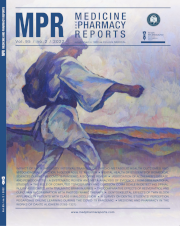The role of computed tomography and Glasgow Coma Scale in detecting spinal injury associated with traumatic brain injuries
DOI:
https://doi.org/10.15386/mpr-2117Keywords:
CT scan, Glasgow Coma Scale, cervical spine injury, fall from height, traumatic brain injuryAbstract
Objectives. The aim of this study is to identify the role of computed tomography scan (CT scan) of the cervical spine and Glasgow Coma Scale (GCS) in detecting spinal injuries associated with head injury.
Methods. This cross sectional study was conducted in the emergency department of Baghdad teaching hospital prospectively from October 2016 to October 2017. A total of 469 patients were included in this study, 59 of them with spine injury. All patients were examined promptly and were treated accordingly; all were subjected to X-rays and CT-scan of the skull and cervical spine for evaluation of head and cervical spinal injury, respectively.
Results. A total of 469 patients were enrolled in this study, mean age of 42.6 ± 13.7 years. The majority of patients were male (383/469) representing 81.7%. There was a significant correlation between Severity of TBI and cervical injury (P<0.001). There was a significant association between cervical injury and the presence of clinical and radiographic findings and associated injuries (P<0.001). It was found that cervical injury was more frequent in patients who were exposed to fall from a height.
Conclusion. CT scan and Glasgow coma scale are highly specific, sensitive, and accurate, with positive and negative predictive values.
Downloads
Published
How to Cite
Issue
Section
License
The authors are required to transfer the copyright of the published paper to the journal. This is done by agreeing to sign the Copyright Assignment Form. Whenever the case, authors are also required to send permissions to reproduce material (such as illustrations) from the copyright holder.

The papers published in the journal are licensed under a Creative Commons Attribution-NonCommercial-NoDerivatives 4.0 International License.

